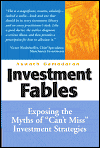Monday, January 23, 2006
Cause and Effect: Stock Market Physics (Part I)
Why should you,as an investor, worry if inflation is rampant? Why does CNBC have one-hour specials on whether the Finance Minister might have said that he might raise interest rates? Why does an expected 8% increase in GDP get mentioned everywhere (especially in blogs with weird titles)? Because they affect your choice of investment, the price you'd pay for that investment and the potential return on (and of) your investment.
Reason enough, I'd say, to look closer. Welcome to the world of macroeconomics, where numbers are large (millions, billions, trillions...) and percentages are small (1% ,5% ,7%...).
What determines stock prices?
The stock price reflects the present value of discounted future earnings of the stock. The oft-used analogy is this: If I say that I will pay you a rupee (or a dollar, if you prefer) every year for eternity from today, how much would you pay me for that privilege?
It depends (why are you not surprised ?!) on
- How much riskier I am than Government securities (G-Secs) or T-Bills
- How much you expect to be compensated for this risk of investing in me over government obligations
Account for the future (with discounts)
We will use a model called the Discounted Cash Flow (DCF) model where the required rate of return is used to discount future rupees to arrive at their present value. The expected rate of return will be used as the discount rate. The running sum of discounted future rupees is the price you ought to pay to get the chosen rate of return. This is mathematically shown as follows for a yearly rupee stream (Note: Rupee(x) denotes present value of a rupee received x years from now):
Rupee (1) = (100% - discount%)1 * 1;
Rupee (2) = (100% - discount%)2 * 1;
.
.
.
Rupee (n) = (100% - discount%)n * 1;
Present Value = Price to Pay = Rupee (1) + Rupee(2) + ...+ Rupee(n) + ...
As you can see, the further you get into the future, the less a rupee then is worth now. Eventually, Rupee(x) is almost zero if x is big enough. This means that the present value will converge to a finite number as those almost-zeros far in the future are too small to affect the running sum very much.
Since we also expect most companies to grow, you can account for expected earnings growth by reducing the discount rate by the expected growth rate as shown:
Rupee(n) = (100% - (discount% - growth%))n * 1;
This is by far one of the simplest valuation methods that assumes ideal conditions but it will serve the purpose of demonstrating what lies beneath a stock's valuation. Some excellent reading material on DCF and other valuation methodologies can be found on moneychimp.
The future is not what it used to be
The price of a stock as valued above depends on:
- expected earnings growth
- required rate of return
- rate of return on risk-free securities
The perceived future changes all the time and that changes one or more of the assumptions built into a stock's valuation. This change, in turn, will necessarily be reflected in rise or fall of stock prices in line with the valuation change. In subsequent parts of this post, the effect of some macro-economic variables on stock valuations will be dealt with.

